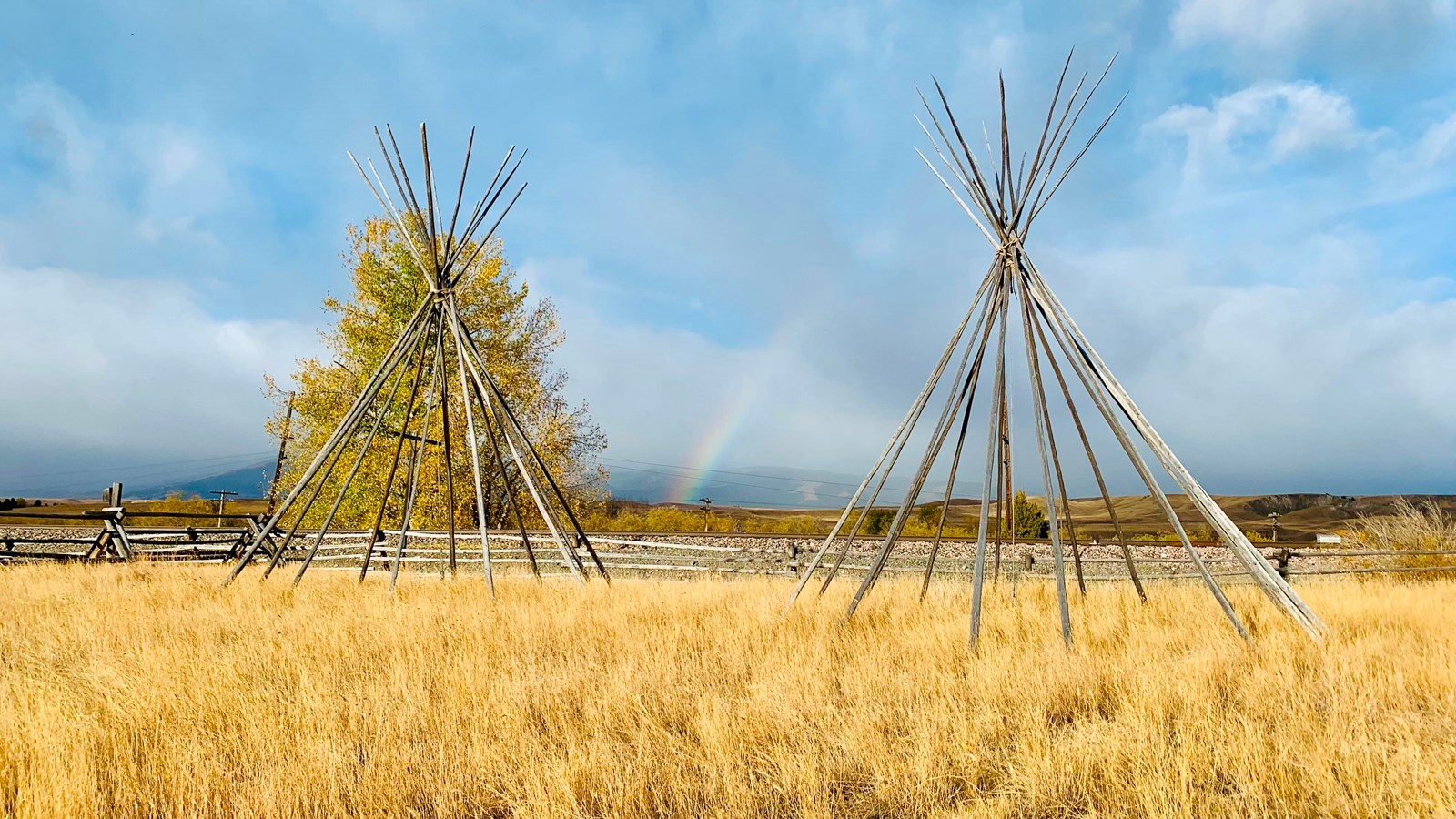Last updated: April 1, 2021
Place
Native Tribes Interpretive Site

NPS/D Shook
Quick Facts
Location:
Deer Lodge, MT
Significance:
Interpretive Site
Designation:
National Historic Site
Amenities
4 listed
Accessible Sites, Cellular Signal, Historical/Interpretive Information/Exhibits, Information
These tipi frames represent the numerous tribes that once passed through the Deer Lodge Valley for generations before the ranch was established by Johnny Grant. Several different Native groups such as the Ql̓ispé (Kalispell/Pend d’Oreille,) Sqelixw (Salish,) Ktunaxa (Kootenai,) Nimiipuu (Nez Perce,) and Siksikaitsitapi (Blackfoot,) used the valley for multiple purposes.
Most of these tribes subsisted on hunting, gathering, and followed their food sources throughout the changing seasons. In the Perce language the valley was known as the “place where you get cached food,” which referred to the abundance of deer in the area. Elk, antelope, and smaller mammals were also regularly hunted. The Deer Lodge Valley was a crucial travel corridor to and from the traditional bison hunting ground to the east. Every part of the bison was used, and nothing was wasted. The animal provided enough food, shelter, tools, and clothing for everyone.
The Clark Fork River and its smaller tributaries provided a reliable, year-round source of fish and other riparian species. A significant part of their diets was supplemented by gathering the various plants, roots and berries that grow throughout western Montana. Because of their migratory patterns following different food sources throughout the year Native peoples constructed portable shelters called lodges or tipi. They were either constructed against saplings or trees, or constructed of poles that were covered with mat, brush, bark, or animal skin. These structures generally served as a shelter for entire families.
The area was also a well-established trade route for many of these Native tribes, which made the valley a perfect location for Johnny Grant to build his ranch and trading post. A drawing of the ranch house done in 1865 by Granville Stuart shows two Siksikaitsitapi present on the front lawn of the house. This suggests that the ranch may have served as an informal trading post and safe camping area for Native groups passing through.
Today, the Deer Lodge Valley still maintains cultural importance with several tribes and appears often in their oral histories. The valley itself gets its name from the Anglicization of a Shoshone word meaning “the white-tailed deer’s lodge.” This refers to a tall, conically shaped mineral deposit and warm spring that is located 16 miles south of the park. The mound closely resembles a lodge or tipi and the rich salt deposits attract deer to the warm spring year-round.
Most of these tribes subsisted on hunting, gathering, and followed their food sources throughout the changing seasons. In the Perce language the valley was known as the “place where you get cached food,” which referred to the abundance of deer in the area. Elk, antelope, and smaller mammals were also regularly hunted. The Deer Lodge Valley was a crucial travel corridor to and from the traditional bison hunting ground to the east. Every part of the bison was used, and nothing was wasted. The animal provided enough food, shelter, tools, and clothing for everyone.
The Clark Fork River and its smaller tributaries provided a reliable, year-round source of fish and other riparian species. A significant part of their diets was supplemented by gathering the various plants, roots and berries that grow throughout western Montana. Because of their migratory patterns following different food sources throughout the year Native peoples constructed portable shelters called lodges or tipi. They were either constructed against saplings or trees, or constructed of poles that were covered with mat, brush, bark, or animal skin. These structures generally served as a shelter for entire families.
The area was also a well-established trade route for many of these Native tribes, which made the valley a perfect location for Johnny Grant to build his ranch and trading post. A drawing of the ranch house done in 1865 by Granville Stuart shows two Siksikaitsitapi present on the front lawn of the house. This suggests that the ranch may have served as an informal trading post and safe camping area for Native groups passing through.
Today, the Deer Lodge Valley still maintains cultural importance with several tribes and appears often in their oral histories. The valley itself gets its name from the Anglicization of a Shoshone word meaning “the white-tailed deer’s lodge.” This refers to a tall, conically shaped mineral deposit and warm spring that is located 16 miles south of the park. The mound closely resembles a lodge or tipi and the rich salt deposits attract deer to the warm spring year-round.
